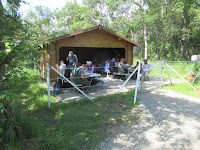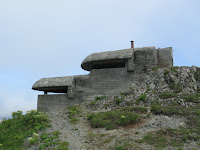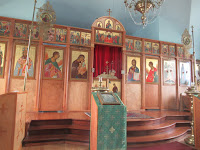 We mentioned that when we were in Katmai National Park, the immense
brown bears didn’t seem to follow the rules at all, walking on the visitor
paths, muscling in on the fishing holes of those fly casting in the Park, and
generally making havoc. Apparently in Anchorage proper they don’t put up with
any of that nonsense at all. Not only do they expect the local moose population
to follow the rules, they also expect that they can read and interpret signage.
We mentioned that when we were in Katmai National Park, the immense
brown bears didn’t seem to follow the rules at all, walking on the visitor
paths, muscling in on the fishing holes of those fly casting in the Park, and
generally making havoc. Apparently in Anchorage proper they don’t put up with
any of that nonsense at all. Not only do they expect the local moose population
to follow the rules, they also expect that they can read and interpret signage. Before leaving the area, we drove then entire 14 miles of
the Alaska Peninsula Highway between King Salmon and Naknek. King Salmon is the
salmon sport fishing capital of the world. Apparently Naknek is the commercial
salmon fishing capital of the world and is 5 times the size of King Salmon. Of
course, that still means its year-round population is well under 500. Just for
a flavor of the area, we lunched at the best restaurant in town. We got lucky
and managed to be in King Salmon and Naknek for their annual Fishtival weekend,
so we got to see some of the doings.
Before leaving the area, we drove then entire 14 miles of
the Alaska Peninsula Highway between King Salmon and Naknek. King Salmon is the
salmon sport fishing capital of the world. Apparently Naknek is the commercial
salmon fishing capital of the world and is 5 times the size of King Salmon. Of
course, that still means its year-round population is well under 500. Just for
a flavor of the area, we lunched at the best restaurant in town. We got lucky
and managed to be in King Salmon and Naknek for their annual Fishtival weekend,
so we got to see some of the doings. Living in RV parks we have become used to seeing new and
interesting things all the time. The ingenuity of some folks carrying their
homes with them on wheels astounds. While I know that necessity is the mother
of invention, I have to admit I have never seen someone take a trailer that had
a bad undercarriage, and just put it on top of another flatbed trailer. Works I
guess!
Living in RV parks we have become used to seeing new and
interesting things all the time. The ingenuity of some folks carrying their
homes with them on wheels astounds. While I know that necessity is the mother
of invention, I have to admit I have never seen someone take a trailer that had
a bad undercarriage, and just put it on top of another flatbed trailer. Works I
guess! Before we head out, I have to say I am still amused by the
road names in Alaska. We are heading for a new adventure to Nome and will be
gone for several weeks. We will be boarding an ice breaker, heading into the
heart of the Bering Sea, and visiting several ports in Siberia. We will be
signing off for a bit, but will pick up where we left off when we get back.
Before we head out, I have to say I am still amused by the
road names in Alaska. We are heading for a new adventure to Nome and will be
gone for several weeks. We will be boarding an ice breaker, heading into the
heart of the Bering Sea, and visiting several ports in Siberia. We will be
signing off for a bit, but will pick up where we left off when we get back.
Talk to you soon!













































